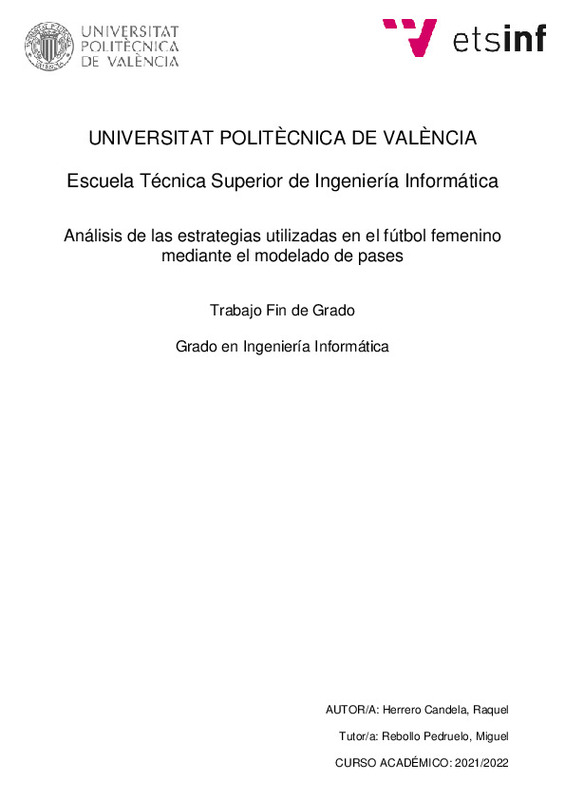JavaScript is disabled for your browser. Some features of this site may not work without it.
Buscar en RiuNet
Listar
Mi cuenta
Estadísticas
Ayuda RiuNet
Admin. UPV
Análisis de las estrategias utilizadas en el fútbol femenino mediante el modelado de pases
Mostrar el registro sencillo del ítem
Ficheros en el ítem
| dc.contributor.advisor | Rebollo Pedruelo, Miguel
|
es_ES |
| dc.contributor.author | Herrero Candela, Raquel
|
es_ES |
| dc.date.accessioned | 2022-10-07T11:55:58Z | |
| dc.date.available | 2022-10-07T11:55:58Z | |
| dc.date.created | 2022-09-20 | |
| dc.date.issued | 2022-10-07 | es_ES |
| dc.identifier.uri | http://hdl.handle.net/10251/187261 | |
| dc.description.abstract | [ES] Las estadísticas son una herramienta utilizada en el mundo del deporte para el análisis de partidos. Estas han ido evolucionando con el paso del tiempo, introduciendo nuevas métricas. En el caso del fútbol masculino, la utilización de analistas de datos por parte de los equipos es cada vez más común. A pesar de que en el fútbol masculino la investigación de nuevas métricas y formas de analizar un partido está en auge no sucede lo mismo con el femenino. Es por eso, que en este TFG analizaremos los partidos de la Copa del Mundo femenina 2019 mediante las redes de pases. Estudiaremos diferentes métricas y visualizaciones de redes, analizando cuales de estas son más útiles para la obtención de datos de interés de un equipo como, por ejemplo, la estrategia utilizada y las jugadoras más importantes. Además, se realizará una pequeña comparación entre fútbol masculino y femenino demostrando que no son tan diferentes como mucha gente piensa | es_ES |
| dc.description.abstract | [EN] The statistics are a useful tool used in the sports world to analyze matches. Over the years, these tools have been improved introducing new metrics. In men’s football, the hiring of data scientists is more and more common. In men’s football there is always a constant learning about new metrics and tactics to analyze a football match, such thing doesn’t happen in women’s football. This is the reason why in this TFG we are going to analyze the FIFA World Cup women’s matches with the help of passing networks. We are going to study different metrics and network visualizations, analyzing the better way to obtain important data of a team, such as, their strategy and most important player. Furthermore, we are going to make a comparation between men and women’s football proving that there is no such big difference between them like the people thinks | es_ES |
| dc.format.extent | 67 | es_ES |
| dc.language | Español | es_ES |
| dc.publisher | Universitat Politècnica de València | es_ES |
| dc.rights | Reserva de todos los derechos | es_ES |
| dc.subject | Fútbol femenino | es_ES |
| dc.subject | Redes de pases | es_ES |
| dc.subject | Métricas | es_ES |
| dc.subject | Análisis | es_ES |
| dc.subject | Women’s football | es_ES |
| dc.subject | Passing network | es_ES |
| dc.subject | Metrics | es_ES |
| dc.subject | Analysis | es_ES |
| dc.subject.classification | LENGUAJES Y SISTEMAS INFORMATICOS | es_ES |
| dc.subject.other | Grado en Ingeniería Informática-Grau en Enginyeria Informàtica | es_ES |
| dc.title | Análisis de las estrategias utilizadas en el fútbol femenino mediante el modelado de pases | es_ES |
| dc.title.alternative | Analysis of strategies used in women's soccer through pass modeling | es_ES |
| dc.title.alternative | Anàlisi de les estratègies utilitzades en el futbol femení mitjançant el modelatge de passades | es_ES |
| dc.type | Proyecto/Trabajo fin de carrera/grado | es_ES |
| dc.rights.accessRights | Abierto | es_ES |
| dc.contributor.affiliation | Universitat Politècnica de València. Departamento de Sistemas Informáticos y Computación - Departament de Sistemes Informàtics i Computació | es_ES |
| dc.contributor.affiliation | Universitat Politècnica de València. Escola Tècnica Superior d'Enginyeria Informàtica | es_ES |
| dc.description.bibliographicCitation | Herrero Candela, R. (2022). Análisis de las estrategias utilizadas en el fútbol femenino mediante el modelado de pases. Universitat Politècnica de València. http://hdl.handle.net/10251/187261 | es_ES |
| dc.description.accrualMethod | TFGM | es_ES |
| dc.relation.pasarela | TFGM\152015 | es_ES |
Este ítem aparece en la(s) siguiente(s) colección(ones)
-
ETSINF - Trabajos académicos [5160]
Escola Tècnica Superior d'Enginyeria Informàtica






